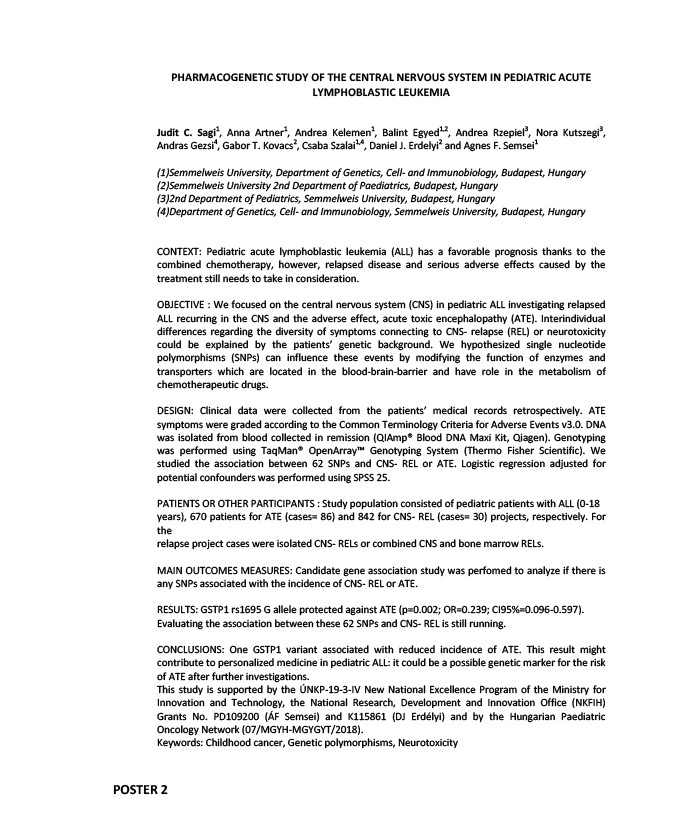
POSTER 2
PHARMACOGENETIC STUDY OF THE CENTRAL NERVOUS SYSTEM IN PEDIATRIC ACUTE
LYMPHOBLASTIC LEUKEMIA
Judit C. Sagi1, Anna Artner1, Andrea Kelemen1, Balint Egyed1,2, Andrea Rzepiel3, Nora Kutszegi3,
Andras Gezsi4, Gabor T. Kovacs2, Csaba Szalai1,4, Daniel J. Erdelyi2 and Agnes F. Semsei1
(1)Semmelweis University, Department of Genetics, Cell- and Immunobiology, Budapest, Hungary
(2)Semmelweis University 2nd Department of Paediatrics, Budapest, Hungary
(3)2nd Department of Pediatrics, Semmelweis University, Budapest, Hungary
(4)Department of Genetics, Cell- and Immunobiology, Semmelweis University, Budapest, Hungary
CONTEXT: Pediatric acute lymphoblastic leukemia (ALL) has a favorable prognosis thanks to the
combined chemotherapy, however, relapsed disease and serious adverse effects caused by the
treatment still needs to take in consideration.
OBJECTIVE : We focused on the central nervous system (CNS) in pediatric ALL investigating relapsed
ALL recurring in the CNS and the adverse effect, acute toxic encephalopathy (ATE). Interindividual
differences regarding the diversity of symptoms connecting to CNS- relapse (REL) or neurotoxicity
could be explained by the patients’ genetic background. We hypothesized single nucleotide
polymorphisms (SNPs) can influence these events by modifying the function of enzymes and
transporters which are located in the blood-brain-barrier and have role in the metabolism of
chemotherapeutic drugs.
DESIGN: Clinical data were collected from the patients’ medical records retrospectively. ATE
symptoms were graded according to the Common Terminology Criteria for Adverse Events v3.0. DNA
was isolated from blood collected in remission (QIAmp® Blood DNA Maxi Kit, Qiagen). Genotyping
was performed using TaqMan® OpenArray™ Genotyping System (Thermo Fisher Scientific). We
studied the association between 62 SNPs and CNS- REL or ATE. Logistic regression adjusted for
potential confounders was performed using SPSS 25.
PATIENTS OR OTHER PARTICIPANTS : Study population consisted of pediatric patients with ALL (0-18
years), 670 patients for ATE (cases= 86) and 842 for CNS- REL (cases= 30) projects, respectively. For
the
relapse project cases were isolated CNS- RELs or combined CNS and bone marrow RELs.
MAIN OUTCOMES MEASURES: Candidate gene association study was perfomed to analyze if there is
any SNPs associated with the incidence of CNS- REL or ATE.
RESULTS: GSTP1 rs1695 G allele protected against ATE (p=0.002; OR=0.239; CI95%=0.096-0.597).
Evaluating the association between these 62 SNPs and CNS- REL is still running.
CONCLUSIONS: One GSTP1 variant associated with reduced incidence of ATE. This result might
contribute to personalized medicine in pediatric ALL: it could be a possible genetic marker for the risk
of ATE after further investigations.
This study is supported by the ÚNKP-19-3-IV New National Excellence Program of the Ministry for
Innovation and Technology, the National Research, Development and Innovation Office (NKFIH)
Grants No. PD109200 (ÁF Semsei) and K115861 (DJ Erdélyi) and by the Hungarian Paediatric
Oncology Network (07/MGYH-MGYGYT/2018).
Keywords: Childhood cancer, Genetic polymorphisms, Neurotoxicity